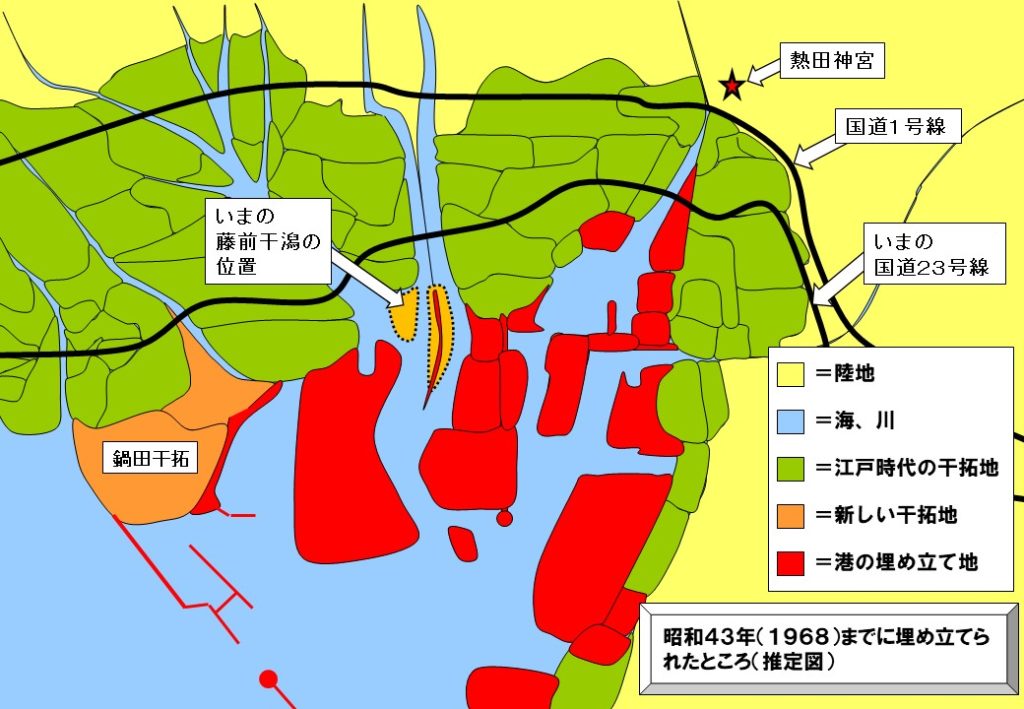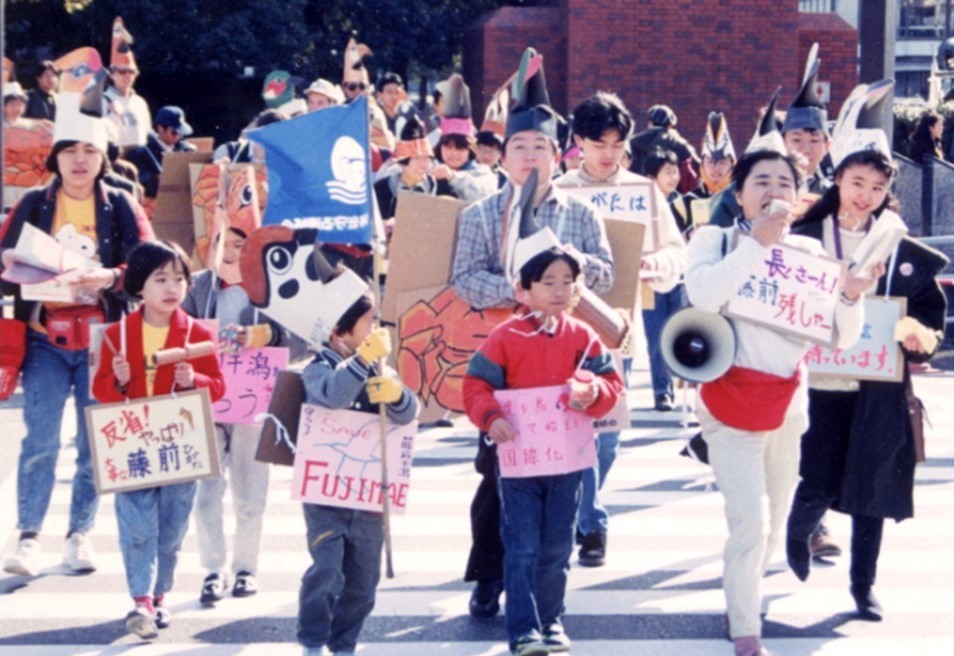AYUCHI FLAT
The southwestern part of present-day Nagoya City was a shallow wetland called “Ayuchi Flat” in ancient times. It was gradually reclaimed and developed for new rice paddies from the Edo period (1603-1868). Reclamation at that time was done manually and took time, and as the work progressed, new tidal flats formed on the sea side. These tidal flats have been used continuously as a stopover site for migratory birds.

*MAP OF NAGOYA PORT AREA circa 1968
Yellow=original land area, Blue=sea, rivers, Green=land developed in Edo Period, Orange=new land development, Red=port industrial park area
A NEW GARBAGE LANDFILL PLAN
During the period of high economic growth from the 1950s, the tidal flats around Nagoya Port were reclaimed for industrial use, and migratory birds began to concentrate on the few remaining tidal flats near the mouth of the Shonai River. The Nagoya City Bird Observation Center, located in Inanaga Park, opened in 1985. This shows that the area was already known as a bird migration site at the time. In 1984, a reclamation plan was announced for such a site. Why?
The answer is garbage: In 1984, the remaining capacity of the Aigi Landfill used by the City of Nagoya (hereinafter referred to as “the City”) was running low, and the shallow area (tidal flat) in front of the Nanyo Garbage Incineration Plant became a candidate for a new landfill. It was an unused area , and in line with the values of the time, people thought they should “reclaim land and put it to good use.”

CITIZENS TAKE ACTION
In response to the plan, a liaison group to protect the tidal flats of Nagoya Port was formed in 1987 (renamed “Save Fujimae Association” in 1991), made up mainly of bird lovers, and submitted a petition to the Nagoya City Council in June 1991, along with 108,000 signatures, calling for tidal flat conservation.
In response to the citizens’ voices, the city changed the plan twice and reduced the landfill area, but continued to promote the project without discussing the actual necessity of a disposal site. As the project progressed, the city released an environmental assessment (*1) brief in 1996, which claimed that the project would have “little impact on the environment
However, since the operator and the assessor were the same city of Nagoya, and since the reliability of the assessment was problematic, the Save Fujimae Association, with the cooperation of experts, conducted its own public survey to scientifically clarify the problems with the city’s assessment and requested that the city conduct an additional survey. In 1998, the City Council issued an assessment that the “impact on the environment is clear” based on the results of that assessment. Because of the differences with the original assessment, a new artificial tidal flat was proposed as a compensatory measure to reduce the impact.
As the issue of the Fujimae Tidal Flat became widely known, the city received numerous appeals from both within Japan and abroad calling for its discontinuation. The Save Fujimae Association appealed for the complete cancellation of the project, showing data that environmental degradation was inevitable even if the landfill area was reduced by half, and that an artificial tidal flat could not compensate for the damage.
FUJIMAE TIDAL FLAT IS SAVED!
In December 1998, the then Environment Agency refused to approve the artificial tidal flat proposed by the city as a compensatory measure, and the then Ministry of Transport, the competent authority for port planning, also announced that it could not grant permission for the project without the consent of the Environment Agency. The following January, a referendum was held by the local Fujimae community association, and with 59 out of 63 members voing against the garbage landfill, local opposition became clear. The city decided that it was impossible to proceed with the plan any further, and on the 25th of the same month, it abandoned the landfill project.

What happened to the garbage that was supposed to be disposed of in the landfill? The city issued a “garbage emergency declaration” upon the cancellation of the project, and by thoroughly separating and recycling garbage, which had been inadequate up to that point, the city sought to reduce the amount of garbage to be landfilled and extend the life of the landfill. Thanks to the cooperation of the administration and efforts by the citizens, the amount of landfill waste has been greatly reduced, and the Aigi Landfill is still in use nearly 40 years after the initial crisis.
1 “Environmental Assessment”: When implementing a large-scale development project, etc., the project proponent must predict and evaluate the impact of the project on the environment in advance and obtain the opinions of residents and relevant local governments, etc., as well as review the content of the assessment from a professional standpoint, so that appropriate environmental considerations can be made in the implementation of the project. This is a series of procedures to ensure that appropriate environmental considerations are made in the implementation of a project.(https://www.kankyo.metro.tokyo.lg.jp/assessment/index.html)
